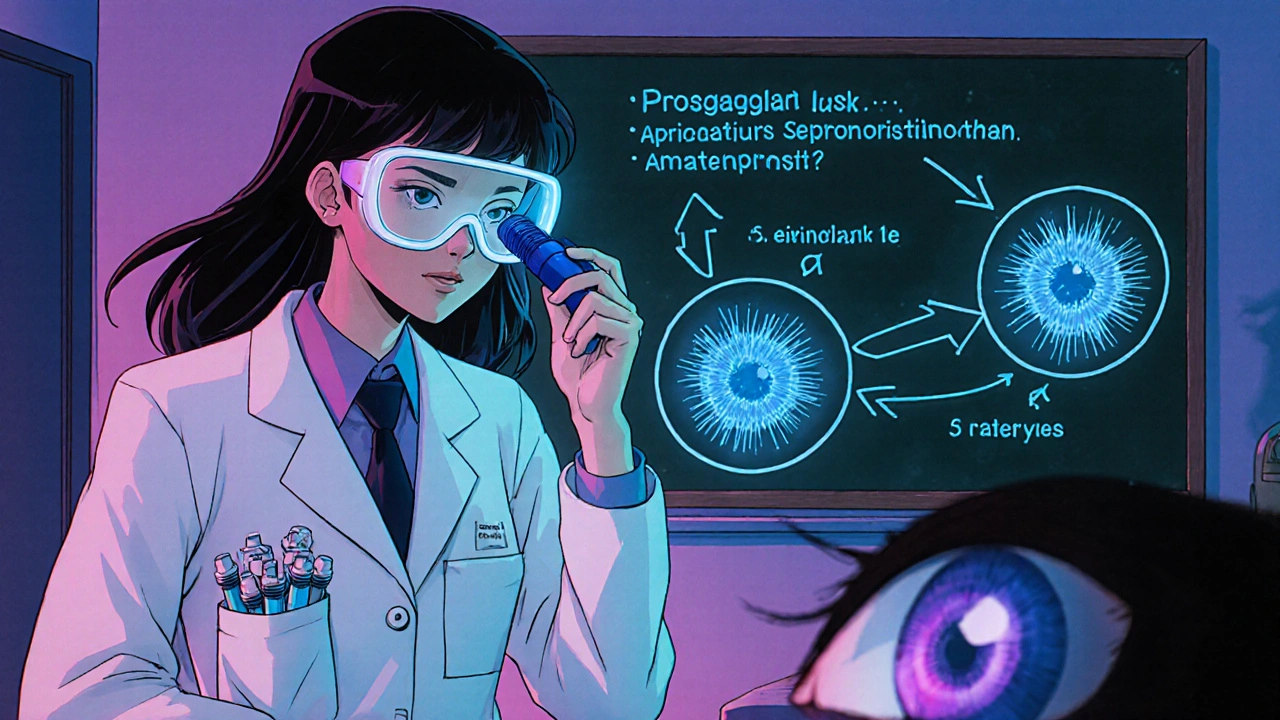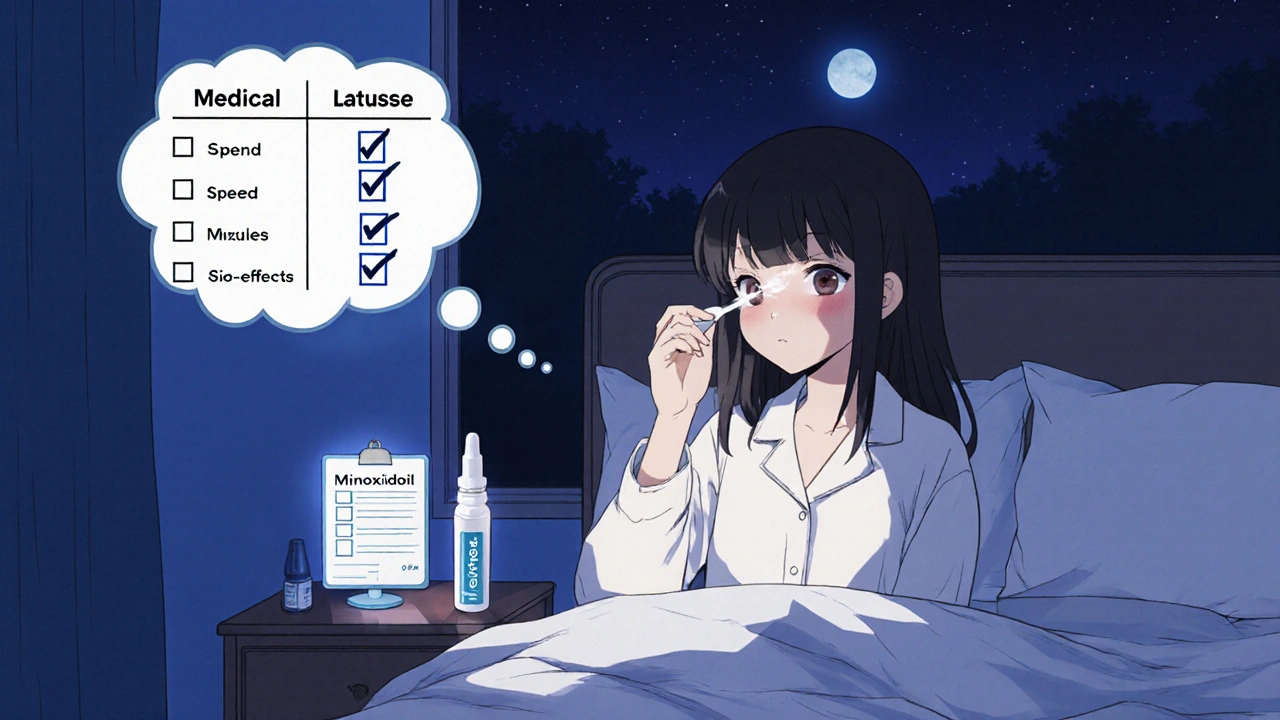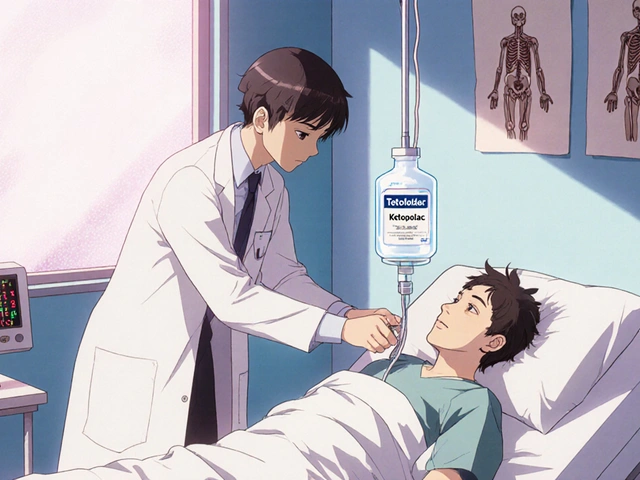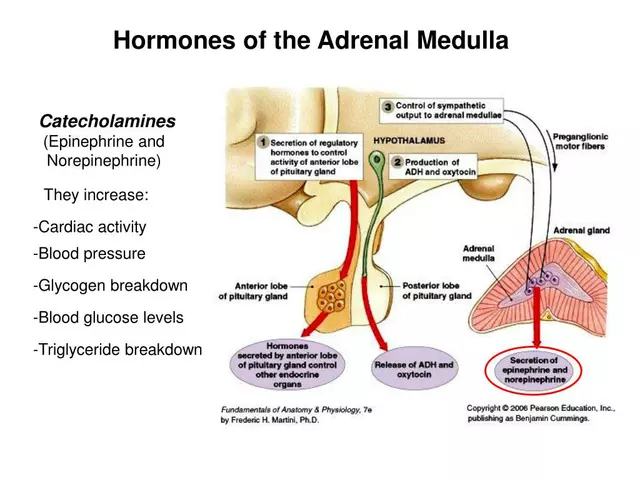Eyelash Growth Treatment Finder
Find Your Best Eyelash Growth Treatment
Answer a few questions to get personalized recommendations for the best eyelash growth option for you.
Key Takeaways
- Latisse (bimatoprost) is the only FDA‑approved prescription for enhancing eyelash length, thickness and darkness.
- Minoxidil and certain prostaglandin analogues (latanoprost, travoprost) are popular off‑label options with varying efficacy.
- Natural oils such as castor oil are low‑risk but lack strong clinical evidence.
- Choosing the right product depends on tolerance, budget, desired speed of results and any eye‑health concerns.
- Always consult an eye‑care professional before starting any ophthalmic solution.
When it comes to fuller, darker lashes, most people think of Latisse. But the market is crowded with off‑label drugs, over‑the‑counter serums and home‑brew oils. This guide breaks down how Latisse stacks up against the most common alternatives, so you can decide whether it’s worth a prescription or if another option fits your needs better.
What Is Latisse (Bimatoprost Ophthalmic Solution)?
Latisse is a bimatoprost‑based ophthalmic solution approved by the FDA to treat hypotrichosis of the eyelashes. It comes in a sterile, single‑use bottle of 0.03% solution applied once nightly to the base of the upper lashes using a disposable applicator. The active ingredient, bimatoprost, was originally developed as a glaucoma medication but was found to stimulate hair follicles in the eyelash region.
How Latisse Works
Bimatoprost belongs to the prostaglandin analogue class. When applied to the lid margin, it binds to prostaglandin‑F‑type receptors on hair follicles, prolonging the anagen (growth) phase and increasing the number of follicles that enter this phase. Clinical trials showed an average increase of 25 % in lash length, 106 % in thickness and 28 % in darkness after 16 weeks of consistent use.
Benefits and Typical Results
- Clinically proven: FDA‑approved with peer‑reviewed data.
- Visible changes start around week 4, with peak results at 12‑16 weeks.
- Effects persist for months after discontinuation, though lashes gradually return to baseline.
- Convenient once‑daily dosing.

Safety Profile and Common Side Effects
Because it’s an ophthalmic medication, Latisse can affect the eye itself. Reported side effects include:
- Eye irritation or redness (≈ 8 % of users).
- Itchy or watery eyes.
- Darkening of the iris (rare, usually reversible if stopped early).
- Hyperpigmentation of the eyelid skin.
Most side effects are mild and resolve when the product is discontinued. However, anyone with a history of glaucoma, uveitis or hypersensitivity to prostaglandins should avoid it.
Off‑Label Alternatives
Several other substances are used to boost lash growth, but they lack FDA approval specifically for that purpose.
Minoxidil (Topical Solution)
Minoxidil is a vasodilator originally marketed for scalp hair loss, often repurposed in 2‑5 % liquid form for lashes. Users apply a tiny dab to the lash line once or twice daily. Small studies suggest modest length gains (≈ 10‑15 % increase) after 3‑4 months, but the data is less robust than for bimatoprost.
Prostaglandin Analogues: Latanoprost and Travoprost
Latanoprost is another prostaglandin‑F‑type analogue approved for glaucoma; it has been used off‑label for eyelashes. Similarly, Travoprost shares the same mechanism. Both show comparable length and thickness improvements to bimatoprost in limited case series, but they carry a higher risk of iris darkening and are not commercially packaged for lash use.
Castor Oil and Other Natural Oils
Castor Oil is a vegetable oil rich in ricinoleic acid, traditionally rubbed onto lashes for nourishment. While it’s inexpensive and gentle, randomized trials have failed to demonstrate a statistically significant effect beyond placebo. Users may notice a temporary sheen, but real growth is minimal.
Commercial Eyelash Serums
Numerous over‑the‑counter serums combine peptides, vitamins (biotin, panthenol) and conditioning agents. Brands such as RevitaLash and RapidLash claim 30‑day results, yet the scientific backing is limited to manufacturer‑sponsored studies. The likelihood of measurable change is lower than prescription options; however, they are popular for their ease of use and lower cost.
Side‑by‑Side Comparison Table
| Feature | Latisse (Bimatoprost) | Minoxidil (2‑5%) | Latanoprost / Travoprost | Castor Oil | OTC Lash Serums |
|---|---|---|---|---|---|
| Regulatory Status | FDA‑approved prescription | Off‑label, FDA‑approved for scalp | Off‑label, FDA‑approved for glaucoma | Natural supplement, no approval | OTC (no FDA indication) |
| Average Length Increase | ~25 % (12‑16 weeks) | ~10‑15 % (12‑16 weeks) | ~20‑25 % (similar to bimatoprost) | Negligible | Variable, often <10 % |
| Thickness Increase | ~106 % | ~30‑40 % | ~80‑100 % | None | ~20‑30 % |
| Darkening Effect | Possible iris darkening (rare) | Rare | Higher iris darkening risk | None | None |
| Typical Cost (US) | $120‑$150 per 5 ml bottle (insurance may cover) | $30‑$40 per 60 ml bottle | $70‑$100 per 5 ml bottle | $5‑$10 per 4 oz bottle | $25‑$55 per 1‑month supply |
| Application Frequency | Once nightly | 1‑2× daily | Once nightly | Once nightly (optional) | Once nightly |
| Prescription Required? | Yes | No | No | No | No |

How to Choose the Right Option for You
Consider these four factors before picking a product.
- Medical History: If you have glaucoma, ocular inflammation or are pregnant, avoid prostaglandin analogues.
- Desired Speed: Latisse typically shows results by week 4; minoxidil may take 8‑12 weeks.
- Budget: Prescription costs can be high, but insurance may help. Over‑the‑counter options are cheaper but less predictable.
- Tolerance for Side Effects: If eye irritation worries you, start with a low‑risk oil and monitor results before escalating.
Many users start with a trial of minoxidil or a natural oil to gauge sensitivity, then switch to Latisse if they need stronger, proven outcomes.
Practical Tips for Safe Application
- Wash hands thoroughly before each use.
- Use a brand‑new applicator every night; never share bottles.
- Avoid direct contact with the eye surface-apply to the skin at the base of the upper lashes only.
- Store the bottle at room temperature, away from direct sunlight.
- If you notice persistent redness, discontinue and see an ophthalmologist.
Frequently Asked Questions
Can I use Latisse on my lower lashes?
The FDA approval covers only the upper eyelashes. Applying it to the lower lashes may increase irritation and has not been studied, so most clinicians recommend against it.
How long does Latisse stay effective after I stop using it?
Lashes gradually return to their original state over 2‑4 months. Some users retain a modest improvement for longer, but the effect does fade without continued treatment.
Is it safe to combine Latisse with an eyelash serum?
Mixing products can increase the risk of irritation. If you want to use a serum, apply it at a different time of day (e.g., morning) and monitor for any redness.
Can men use Latisse?
Yes. The medication works the same regardless of gender, and many male patients use it for both cosmetic and therapeutic reasons (e.g., treating eyelash loss after chemotherapy).
What should I do if I accidentally get Latisse in my eye?
Rinse the eye gently with sterile saline or clean water for at least 15 minutes and contact your eye doctor if irritation persists.
Whether you opt for the prescription gold standard or experiment with an alternative, consistent application and realistic expectations are the keys to achieving noticeable, healthy lashes.








Latisse definitely shows the strongest data, but if you have sensitivity issues minoxidil can be a decent backup. Just keep the application clean and watch for irritation.
First off, thanks for putting together such a solid overview-this kind of clarity really helps newcomers navigate the lash‑growth jungle. If you’re on a budget, start by testing a small patch of skin with any new serum to gauge tolerance before committing to a full bottle. Remember that results are cumulative; you won’t see dramatic change overnight, but consistency over 12–16 weeks is key. For those with a history of eye conditions, stick to FDA‑approved Latisse and keep regular check‑ins with your optometrist. If you’re adventurous, a low‑dose minoxidil trial can add a modest length boost without breaking the bank. Natural oils like castor are harmless, but don’t expect miracle growth-think of them as moisturizers rather than enhancers. Finally, track your lash measurements with a simple ruler or photo log; data beats anecdote every time. Stay patient, stay safe, and enjoy the flutter!
If cost is a concern, start with a generic prostaglandin like latanoprost. It’s cheaper but you still need a prescription.
I totally get the fear of eye irritation-my sister stopped Latisse after a few weeks because of redness. What helped her was rinsing the applicator tip with sterile saline before each use. Also, applying a thin layer along the lash line rather than dripping prevents excess contact. Keeping a backup bottle handy in case of contamination is wise. Ultimately, listening to your own comfort signals will keep your lashes healthy.
Ah, the classic “cheaper version” gambit-sure, why not sprinkle a little corporate‑grade eye drop on your lids and hope for the best? In reality, those off‑label prostaglandins come with their own set of mysteries, from unpredictable iris darkening to the occasional covert micro‑inflammation that your doctor might never see. And let’s not forget the supply‑chain conspiracies that ensure only the privileged get the real formula while the rest get a placebo disguised as “generic.” So, if you’re truly budget‑conscious, maybe consider simply embracing your natural lash pattern-no secret agenda required.
I echo the emphasis on measurement; a simple millimeter ruler on a photo can turn subjective hope into objective progress.
I just stick with castor oil because it’s cheap.
When you parse the pharmacodynamics of bimatoprost versus minoxidil you quickly realize that the former modulates the FP receptor cascade while the latter acts as a potassium channel opener. This mechanistic divergence translates into differential anagen phase elongation kinetics that are quantifiable via trichoscopic imaging. Clinical meta‑analyses consistently report a mean lash length increment of ~2.4 mm for bimatoprost after 12 weeks versus ~1.1 mm for topical minoxidil. Moreover, the safety profile is stratified by ocular surface homeostasis markers such as tear break‑up time and conjunctival hyperemia index. Patients with pre‑existing blepharitis tend to manifest heightened inflammatory scores when exposed to prostaglandin analogues. From a cost‑effectiveness standpoint, the incremental cost‑utility ratio (ICUR) favors Latisse only in high‑value cohorts with severe hypotrichosis. Conversely, low‑budget users may achieve acceptable cosmetic outcomes with OTC peptide‑rich serums albeit with higher variability. It’s also worth noting that the vehicle viscosity influences drug diffusion-high‑viscosity gels can retard permeation and reduce efficacy. Formulation excipients such as benzalkonium chloride have been implicated in epithelial toxicity, a factor often overlooked in consumer reviews. In terms of consumer adherence, once‑daily dosing aligns with circadian rhythms, optimizing receptor occupancy during the nocturnal growth window. Real‑world data from patient registries indicate a dropout rate of roughly 12 % for Latisse due to ocular discomfort. Switching to latanoprost or travoprost off‑label may mitigate iris pigmentation side‑effects but introduces a different risk profile concerning peri‑ocular hyperpigmentation. For clinicians, the decision algorithm should integrate baseline iris color, glaucoma history, and patient preference for invasiveness. Finally, emerging nanocarrier systems promise targeted delivery, potentially enhancing lash follicle uptake while minimizing corneal exposure 😎🚀. Bottom line stay informed, discuss with your ophthalmologist, and weigh the quantitative benefits against the qualitative side―effects 😅.
That whole nanocarrier hype sounds like a marketing ploy-I’ve seen similar “next‑gen” claims fizzle out, and the eye isn’t a playground for untested delivery vectors. Stick to what the FDA actually backs and skip the buzz.
Sure, the “nanotech” buzz is just another layer of the grand ocular conspiracy where big pharma pushes expensive drops while keeping cheap alternatives under wraps. If you think they’re not hiding something, you’ve been reading the press releases too fast.
The breakdown is solid but I have to call out the bias toward prescription stuff-people love the pricey brand names and ignore cheaper DIY hacks that actually work for most.
I hear the frustration, yet it’s important to keep a boundary between anecdotal hacks and evidence‑based practice; the latter protects us from unintended damage.